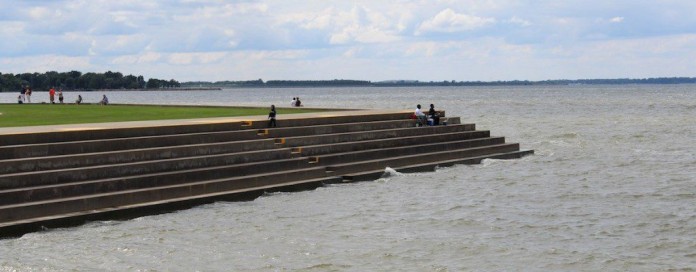COVID-19 certainly hasn’t helped water quality work this year, but it hasn’t stopped it, either.
In an overview of the 2020 harmful algal bloom season for a Lake Erie science writers workshop Oct. 28, Chris Winslow, director of Ohio Sea Grant, said, despite budget cuts and social distancing challenges, researchers have still been collecting and testing water samples in and around the lake.
“We were more hindered by the ability of people to get out because of social distancing constraints, rather than budget,” Winslow said. “I think we weathered the storm pretty well.”
And the July 2020 forecast for the harmful algal bloom season on Lake Erie turned out to be a slight overestimate. Researchers predicted that on a severity index of 0-11, the bloom this year would rank around a 4.5.
The actual bloom wound up at only a 3, according to the National Oceanic and Atmospheric Administration’s Oct. 29 seasonal assessment. Strong winds in September might have contributed to a milder bloom. This bloom was much less severe than the 2019 bloom, which had a rating of 7.3.
But despite a smaller bloom this year, more work is needed to achieve water quality targets.
Budgets
Nutrient runoff from farmland, particularly phosphorus, contributes to harmful algal blooms in Lake Erie. The H2Ohio program is a water quality initiative that includes a program to help farmers implement best management practices to reduce runoff from their fields.
In an Oct. 29 H2Ohio update for the workshop, Sandra Kosek-Sills, environmental specialist for the Lake Erie Commission, said the Ohio Department of Agriculture is still finalizing contracts with farmers before getting a final number on the amount of acres and practices will be involved in the program. She said those numbers could be reported as soon as the end of the year.
The state department of agriculture got just shy of $50 million for H2Ohio programs through H2Ohio and Senate Bill 299 for fiscal year 2020. Kosek-Sills said the department is hoping to get the 2020 funds under contract with farmers by the end of the calendar year.
Program administrators were originally hoping to get four years out of the initial program funding — but they were also originally only expecting to see a few hundred farmers sign up, Kosek-Sills said.
“Well, they had 2,000 people and they wanted … to get all the folks who were interested started,” she said.
With more people involved, the program was shortened to two years — fiscal years 2020 and 2021. The same amount of money from H2Ohio has been allocated to the department of agriculture program for fiscal year 2021. But with state budgets still up in the air during the pandemic, it remains to be seen whether or not the program will get to spend those funds, Kosek-Sills said.
Practices
The pandemic did delay deploying funds and practices with farmers. Next spring, she said, farmers will actually be able to start implementing practices and getting reimbursed for those practices.
In order to cut nutrients going into the lake by 40% from the 2008 numbers, which would result in an acceptable bloom level for most years, about 65-85% of the farming acres in the Maumee watershed need to have best management practices adopted, Winslow said.
Adopting those practices is expensive, Winslow said, and while there have been some reductions in nutrient runoff locally, there hasn’t been a measurable decline on the Lake Erie scale yet. And the weather from year to year also makes it hard to measure.
“We’re confounded by the variation in rainfall,” he said.
The rainfall in 2019 also revealed issues with legacy phosphorus, which is phosphorus that is in fields from previous fertilizer applications. Though the rain kept many farmers from applying fertilizer in fall 2018 and spring 2019, there was still a relatively large amount of runoff.
Studies suggest that 20-35% of phosphorus runoff could be legacy phosphorus, Winslow said. Some studies suggest it could be more.
“It’s not an issue that’s going to be solved overnight,” Winslow said.
Continued work
Researchers and state agencies are continuing to work on the lake’s water quality issues. There has been progress in some areas. Scott Hardy, extension educator with Ohio Sea Grant, talked about progress on the Cuyahoga Area of Concern for the workshop.
The area includes the lower 46.5 miles of the Cuyahoga River, 21 subwatersheds and 10 miles of Lake Erie shoreline. The area originally had a list of 10 beneficial use impairments to be addressed. Three out of the 10 beneficial use impairments have been determined to be no longer impaired and removed from the list in recent years.
The removed impairments are restrictions on fish consumption, public access and degraded aesthetics. This means there are no additional restrictions on consuming fish caught in the Cuyahoga River, there is more access to public spaces and recreation around the river and the river no longer has observed or ongoing sludge deposits and scum.
“These are no small tasks,” Hardy said.
The area’s advisory committee is continuing to work on impairments including “eutrophication,” or undesirable algae, loss of fish habitat, dredging restrictions and fish population challenges.
Collaboration
Recently, state agencies involved in water quality have asked Lake Erie researchers to start hosting yearly two-day workshops with agency staff to present findings and data. They have also asked Winslow and other several key researchers to meet with agency directors each month to present highlights of any research results.
“The agencies are recognizing that these research projects are not just resulting in scientific publications, but have the ability to inform management decisions,” Winslow said.
Ohio Attorney General David Yost also recently put together a scientific advisory council of environmental scientists to help provide guidance on preserving Ohio’s natural resources. Winslow is one of the council’s co-chairs.











